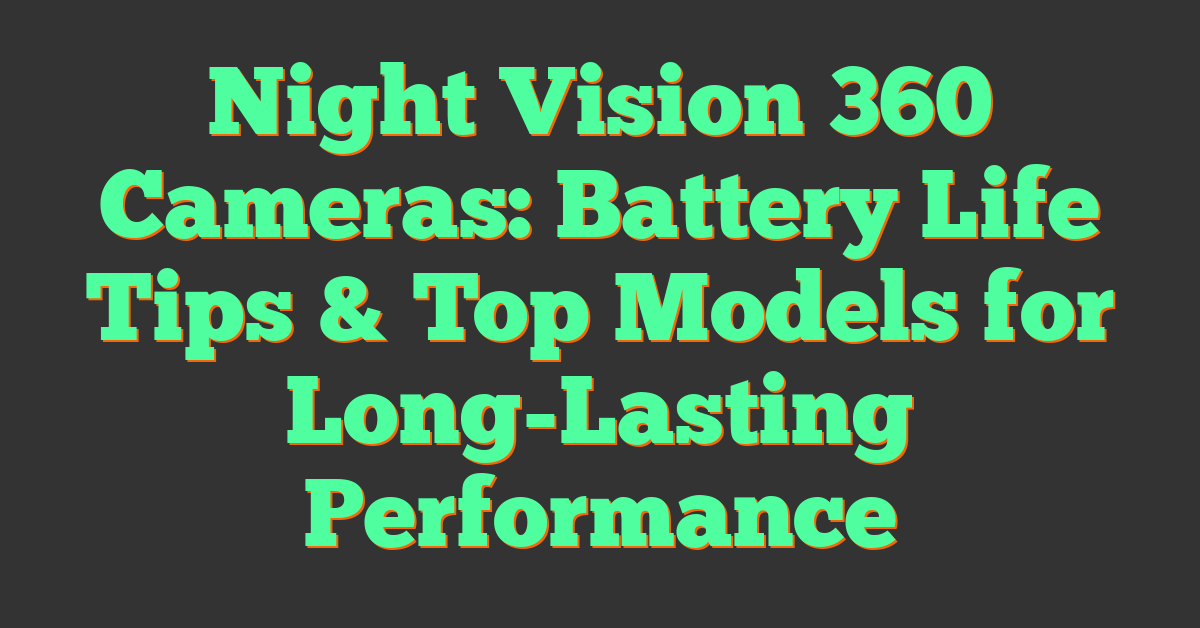Key Takeaways
- Battery life is crucial for night vision 360 cameras, impacting their usability in security, outdoor adventures, and professional projects. A reliable battery ensures uninterrupted performance.
- High-resolution recording and infrared usage significantly drain battery power, reducing runtime by up to 40% in some cases. Choose cameras that balance features and energy efficiency.
- Environmental conditions, such as extreme cold or heat, affect battery performance. Proper storage and handling can help maintain efficiency during challenging weather.
- Optimizing settings, like lowering resolution or disabling unnecessary features (e.g., Wi-Fi), extends battery life and maximizes shooting time.
- Investing in swappable batteries or external power packs prevents interruptions, ensuring long and consistent recording sessions, especially in remote or demanding environments.
- Top-performing models like the Insta360 ONE RS, Ricoh Theta Z1, and Labpano Pilot One EE deliver strong battery endurance alongside advanced night vision capabilities for versatile use cases.
When it comes to night vision 360 cameras, battery life can make or break their performance. These cameras are designed to provide all-around visibility, even in complete darkness, but none of that matters if the battery dies too quickly. Whether you’re using them for security, outdoor adventures, or professional projects, understanding how long they last on a single charge is crucial.
I’ve noticed that not all night vision 360 cameras are created equal when it comes to power efficiency. Factors like resolution, infrared usage, and recording settings can heavily impact battery performance. So, how do you choose one that balances functionality and longevity? Stick around as I break down what affects battery life and how to get the most out of your camera.
Importance Of Battery Life In Night Vision 360 Cameras
Battery life impacts how effective a night vision 360 camera is in real-world scenarios. Whether capturing nighttime landscapes, filming virtual tours, or monitoring a location overnight, long-lasting power ensures uninterrupted performance. Without a reliable battery, extended shoots or surveillance can quickly become impractical.
Continuous shooting with high-resolution settings and infrared lighting drains batteries faster. In my experience, recording in 4K or higher resolution with active infrared LEDs can cut operating times by as much as 40%, compared to lower-resolution or daylight settings. This makes battery efficiency a critical factor when selecting a camera.
Portability also depends on battery life. Night vision 360 cameras are often used in remote or outdoor settings where charging isn’t always possible. A camera with robust battery support allows users to work longer without worrying about power shortages, especially during extended shoots.
Extended battery performance reduces interruptions during projects. Switching batteries in the middle of recording breaks immersion, which is crucial for capturing seamless 360 videos or images. A dependable battery lets me focus on composition and angles without constantly monitoring power levels.
For photographers and videographers, battery life directly influences productivity. Efficient power management enables more footage, more experimentation with angles, and less time spent recharging. When choosing a model, I always evaluate advertised runtime against real-world usage, especially under night vision workloads.
Factors Affecting Battery Life
Battery life in night vision 360 cameras depends on a combination of design elements and real-world usage. After spending years capturing immersive VR scenes and working with 360 camera technology, I’ve seen how specific factors can dramatically impact battery performance.
Power Consumption Features
Integrated features like infrared lighting and high-resolution recording require significant energy. Night vision functionality increases power demands due to constant infrared illumination, which ensures clear footage in low light. Cameras supporting 4K or higher resolutions drain batteries faster because processing and storing large amounts of data consume more energy.
« How to Choose a 360 Camera for Real Estate: Top Tips to Elevate Your Property Listings
Professional 360 Cameras for Live Events: Top Picks to Transform Audience Experience »
Stabilization systems, like gyroscopic or electronic image stabilization, also affect battery consumption. While these improve video quality, they use additional processing power. When considering a camera, I recommend looking beyond the advertised battery runtime and factoring in which features you’ll frequently use.
Environmental Conditions
Environmental factors can limit battery capacity and efficiency. Cold temperatures decrease battery performance, as lithium-ion cells slow down in low-temperature environments. When I’ve shot in areas below freezing, I noticed cameras needed recharges far more frequently. High humidity can also degrade battery life over time if moisture infiltrates the camera’s battery compartment.
On the other hand, hot conditions can cause batteries to overheat and temporarily shut down. To maximize battery longevity, I suggest using temperature-regulated storage and monitoring your camera during extreme weather.
Usage Patterns
Battery life varies depending on how you operate the camera. Long sessions with continuous video recording or intensive night vision will deplete energy reserves faster. In my experience, enabling power-hungry features like 360-degree panoramic shots or extended filming sessions at high frame rates can halve the expected battery life compared to sporadic image capturing.
Additionally, frequent use of wireless features, such as live streaming or remote app connectivity, adds strain on power sources. Turning off unused features or taking breaks between shoots can conserve energy. As a tip, carrying spare batteries or investing in external battery packs has saved several of my outdoor shoots from cutting short due to power failure.
Top Night Vision 360 Cameras With Long Battery Life
Long battery life plays a crucial role in ensuring uninterrupted, high-quality recordings for night vision 360 cameras. Based on my experience and research, I’ve outlined three exceptional options that balance features and endurance.
Camera 1: Features And Battery Performance
The Insta360 ONE RS 1-Inch 360 Edition combines Leica optics with competitive battery endurance. Its modular design supports a 1350mAh battery, offering up to 75 minutes of recording at 6K resolution with active HDR. The camera integrates infrared capabilities, ensuring crisp footage in low-light environments while efficiently managing power consumption. For extended sessions, the modular battery is swappable, making this camera ideal for overnight landscape shots or continuous monitoring.
Camera 2: Features And Battery Performance
The Ricoh Theta Z1 features dual 1-inch sensors and delivers exceptional low-light performance. Its 1350mAh battery achieves up to 60 minutes of continuous 4K recording with night vision enabled. This model excels in delivering sharp details under poor lighting, thanks to optimized power management and minimal energy draw from stabilization and internal processing. The USB-C charging allows for quick top-ups when paired with portable power banks, making it suitable for outdoor and event videography.
Camera 3: Features And Battery Performance
The Labpano Pilot One EE offers intuitive all-in-one capabilities with an impressive 4800mAh battery, lasting up to 3 hours on a single charge while recording in 6K. Integrated infrared LEDs ensure superior night vision without excessive energy consumption. This camera’s efficient cooling system prevents battery degradation during long usage. Photographers can rely on it for immersive VR content creation or extended nighttime time-lapse projects without frequent interruptions.
Tips To Extend Battery Life
Efficient battery management is key to getting the most out of night vision 360 cameras in challenging lighting or remote locations. By carefully optimizing settings and choosing the right accessories, longer recording sessions and uninterrupted shooting become achievable.
Optimizing Settings
Adjusting camera settings significantly reduces energy consumption. Lowering resolution from 6K to 4K or reducing frame rates can extend runtime without sacrificing too much quality. For example, shooting timelapses instead of continuous video requires less power while producing creative results.
Disabling unnecessary features like Wi-Fi or Bluetooth when not in use minimizes background power drain. If infrared lighting isn’t immediately needed, switching it off preserves battery capacity. In my experience, enabling power-saving modes, commonly built into many 360 cameras, effectively limits energy usage by adjusting brightness and auto-dimming displays.
Temperature directly affects battery efficiency. Cold environments reduce capacity, so storing your camera and battery in a temperature-controlled pouch before shooting maintains performance. If shooting in extreme weather, keep spare batteries warm until needed.
Choosing The Right Accessories
Reliable accessories prevent mid-shoot disruptions. Swappable batteries like those in the Insta360 ONE RS are excellent for extended projects, and I carry at least two spares for uninterrupted sessions. High-quality external battery packs with 10,000mAh or more capacity can power cameras during lengthy shoots, particularly for static setups like overnight surveillance or star trails.
Using low-power storage options also helps. Select high-speed, energy-efficient microSD cards, as older cards may increase processor workload and consumption. USB-C charging hubs allow simultaneous charging of multiple batteries, ensuring you never run out of power when shooting on location.
With these adjustments and tools, consistent footage capture becomes seamless, whether you’re documenting nature or creating 360 immersive virtual tours.
Conclusion
Battery life plays a pivotal role in the functionality and reliability of night vision 360 cameras, especially in demanding environments. Choosing a camera that balances performance with endurance ensures uninterrupted recording and peace of mind during critical moments.
By understanding the factors that impact battery longevity and adopting practical strategies to optimize usage, you can make the most of your equipment. Whether you’re capturing stunning nightscapes or monitoring remote locations, efficient power management keeps your focus where it matters most—on creating exceptional footage.









